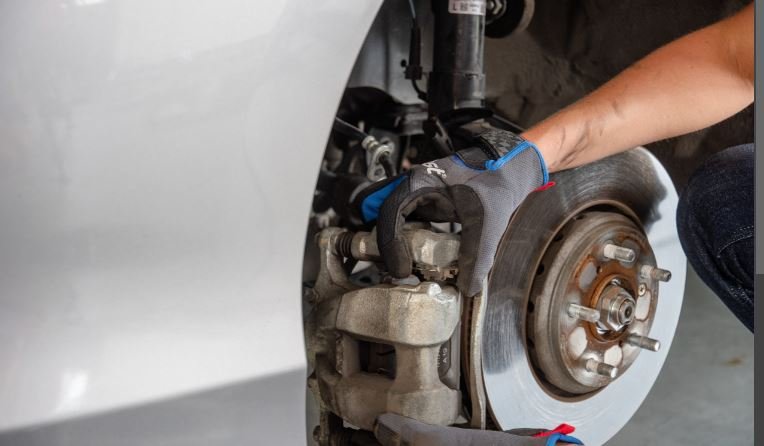The brake caliper plays a crucial role in your vehicle’s braking system by clamping down on the brake rotors to slow or stop the vehicle. Understanding how brake calipers work and how to maintain them can significantly impact your vehicle’s braking performance and safety. This guide will cover the essential aspects of brake calipers, including their functions, types, and maintenance tips.

1. What Is a Brake Caliper?
A brake caliper is a critical component of a disc brake system. It houses the brake pads and squeezes them against the brake rotor when the brake pedal is pressed. This action creates the friction necessary to slow down or stop the vehicle. The caliper contains pistons that push the brake pads into contact with the rotor, generating the required braking force.
2. Types of Brake Calipers
There are several types of brake calipers, each with distinct features and benefits:
- Floating Calipers: These calipers move horizontally and use a single piston to apply pressure. They are common in many vehicles due to their simplicity and cost-effectiveness.
- Fixed Calipers: Fixed calipers have pistons on both sides of the rotor, providing more consistent braking performance. They are often in use in high-performance and luxury vehicles.
- Brembo Calipers: Known for their high-performance capabilities, Brembo calipers are used in many sports and luxury cars. They offer superior braking power and heat dissipation.
3. How Brake Calipers Work
When you press the brake pedal, hydraulic pressure is transmitted through the brake lines to the caliper. This pressure forces the pistons inside the caliper to push the brake pads against the rotor. The friction generated between the pads and rotor slows down the wheel, bringing the vehicle to a stop. The caliper then retracts, allowing the wheel to rotate freely once the brakes are released.
4. Signs of Brake Caliper Problems
Recognizing signs of brake caliper issues can prevent further damage and ensure safe driving. Common signs include:
- Uneven Brake Wear: If the brake pads wear unevenly, it may indicate a problem with the caliper’s movement or alignment.
- Pulling to One Side: A vehicle pulling to one side during braking can be caused by a sticking or malfunctioning caliper.
- Brake Noise: Squeaking, squealing, or grinding noises can signal that the caliper is not functioning correctly or that the brake pads are worn.
5. Maintaining Brake Calipers
Proper maintenance of brake calipers is essential for optimal braking performance and longevity. Here are some maintenance tips:
- Regular Inspections: Check the calipers regularly for signs of leakage, corrosion, or damage. Ensure they are properly aligned and functioning smoothly.
- Lubrication: Apply lubricant to the caliper slides and pins to prevent sticking and ensure smooth movement. Use high-temperature brake lubricant for best results.
- Bleeding the Brakes: Periodically bleed the brake system to remove air bubbles that can affect caliper performance.
6. Replacing Brake Calipers
If a brake caliper fails or becomes too damaged, replacement is necessary. Follow these steps for replacement:
- Lift the Vehicle: Use a jack and jack stands to lift and secure the vehicle.
- Remove the Old Caliper: Detach the caliper from the mounting bracket and remove it from the rotor. Disconnect the brake line and carefully remove the caliper.
- Install the New Caliper: Attach the new caliper to the mounting bracket and connect the brake line. Ensure proper alignment and secure the caliper in place.
- Bleed the Brakes: Bleed the brake system to remove any air from the lines and ensure proper braking performance.
7. Choosing the Right Brake Caliper
Selecting the right brake caliper involves considering several factors:
- Vehicle Specifications: Ensure the caliper is compatible with your vehicle’s make and model.
- Performance Needs: Choose a caliper that meets your performance requirements, whether for daily driving or high-performance applications.
- Quality and Brand: Opt for high-quality calipers from reputable brands to ensure reliability and performance.
8. Caliper Rebuilding
In some cases, rebuilding a brake can be a cost-effective alternative to replacement. This process involves disassembling the caliper, replacing worn seals and pistons, and reassembling it. Rebuilding can restore the caliper’s functionality and extend its lifespan.
9. Upgrading Calipers
For enhanced braking performance, consider upgrading to high-performance calipers. Upgraded calipers offer improved stopping power, better heat dissipation, and increased durability. Performance calipers are particularly beneficial for sports cars and vehicles used in demanding driving conditions.
10. Professional Assistance
If you’re unsure about diagnosing or repairing brake caliper issues, seek professional assistance. A qualified mechanic can accurately diagnose problems, perform necessary repairs, and ensure that your braking system operates safely and effectively.
Conclusion
Understanding brake calipers is essential for maintaining a safe and effective braking system. Recognizing signs of caliper issues, performing regular maintenance, and knowing when to replace or upgrade calipers can significantly impact your vehicle’s performance and safety. Whether you are performing routine checks or addressing problems, proper care of your brake calipers ensures reliable and responsive braking.




